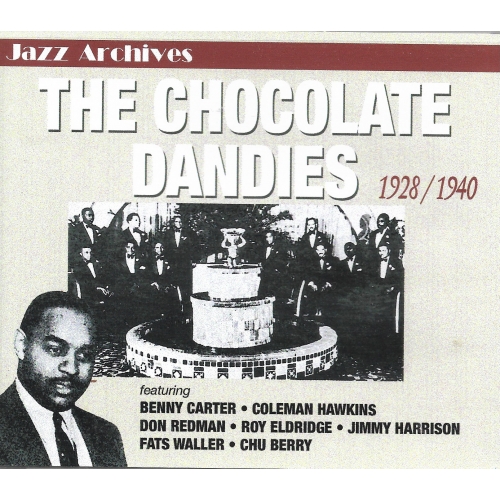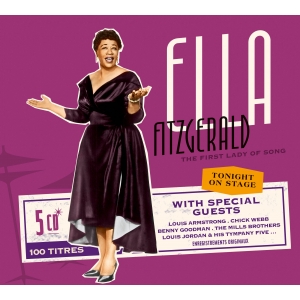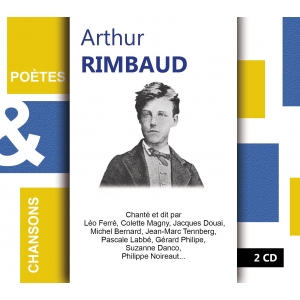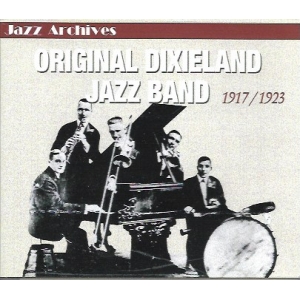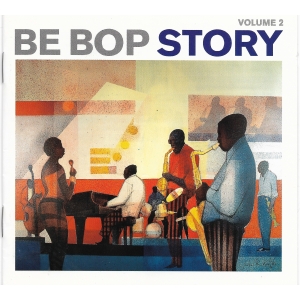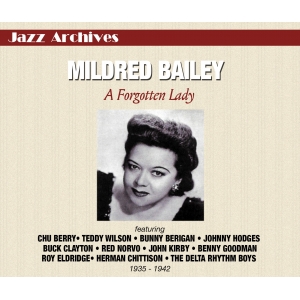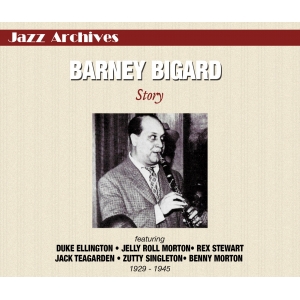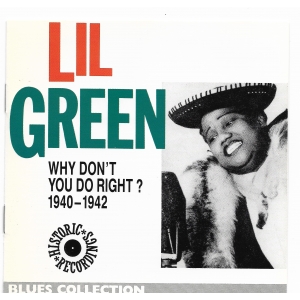THE CHOCOLATE DANDIES
VOUS RECEVREZ UN BON D'ACHAT 10% À PARTIR DE 40 € DE COMMANDE
1 Paducah (D.Redman) 2’54
2 Stardust (H. Carmichael) 2’54
3 Birmingham breakdown (D. Ellington) 2’35’’
4 Four or five times (Hellman) 3’10
5 That’s how I feel Today (D. Redman) 2’55’’
6 Six or seven times (Waller-Mills) 3’18’’
7 Goodbye blues (B. Carter) 3’20’’
8 Cloudy skies (C. Hawkins) 2’52’’
9 Got another sweetie now (J. Harrison) 2’57’’
10 Buggle call rag (Pettis-Mills) 2’47’’
11 Dee blues (B. Carter) 2’53’’
12 Blue interlude (B. Carter) 3’20’’
13 I never knew (Fiorito-Khan) 3’00’’
14 Once upon a time ( B. Carter) 3’20’’
15 Krazy Kapers (B. Carter) 3’24’’
16 Smack (L. Feather) 2’36’’
17 I surrender dear (Clifford-Barris) 4’29’’
18 I can’t believe that you are in love with me (Gaskill-McHugh) 4’06’’
19 Scratch my back (Carter-Polo-Sullivan) 3’17’’
20 A pretty girl is like a melody (I. Berlin) 2’54’’
21 Pom-pom (B. Carter) 3’12’’
Les enregistrements
1-4 Langston Curl, John Nesbitt, Claude Jones (tp), Don Redman (cl,as,vo), Milton Senior (cl,as), George Thomas (cl, as,ts,vo), Prince Robinson (cl,ts), Todd Rhodes (p), Lonnie Johnson (g), Dave Wilburn (bjo)vo), Ralph Escudero (tu), Cuba Austin (dm) / 1928
5-6 Red Stewart (cnt), Leonard Davis (tp), J. C. Higginbotham (tb), Don Redman (cl, as, vo), Fats Waller (p), unknown (bjo), Benny Carter (cl, as,vo), Coleman Hawkins (ts), Cyrus St. Clair (tu), George Stafford (dm) / 1929
7-17 Bobby Stark (tp), Jimmy Harrison (b, vo), Benny Carter (as, cl), Coleman Hawkins (ts), Horace Henderson (p), Benny Jackson (g), John Kirby (b) / 1930
12-15 Max Kaminsky (tp), Benny carter (as), Floyd O’Brien (tb), Chu Berry (ts), Teddy Wilson (p), Lawrence Lucie (g), Ernest Bass Hill (b), Sidney Catlet (dm), Mezz Mezzrow (dm on 15) / 1933
16-18 Roy Eldridge (tp), Benny Carter (as), Coleman Hawkins (ts), Bernard Addison (g), John Kirby (b), Sidney Catlet (dm) / 1940
19 The Varsity Seven : Benny Carter (tp,as), Danny polo (cl), Coleman Hawkins (ts), Joe Sullivan (p) ; Ulysses Livingston (g), Artie Bernstein (b), George Wettling (dm) / 1939
20-21 Same mais Artie Shapiro (b) / 1940
THE CGOCOLATE DANDIES
Il est paradoxal d'attribuer une unité nominale à une formation dont la seule réalité est d'avoir existé à l'occasion de séances de studio, échelonnées sur douze années, cinq en tout. L'ensemble s'appelle bien The Chocolate Dandies, encore faut-il préciser que d'autres groupes ont utilisé ce nom, puisqu'il servit aussi aux Mills Blue Rhythm Band (un titre pour Vocalion en 1931), King Oliver (trois titres la même année pour le même label) et aux Lloyd Smith's Gut-Bucketeers (pour Vocalion, trois séances en 1930), l'ensemble ne comportant aucun Lloyd Smith, le seul Smith en cause étant le grand Jabbo et on ignore pratiquement tout du personnel de ces séances, dont on avance que le cornettiste serait Punch Miller, accompagné par quelques Unknowns (famille bien connue dans le jazz).
Des points communs entre les faces ici présentées, il en existe au moins un (en dehors du nom du groupe), la présence de Don Redman ou de Benny Carter, parfois des deux , ce qui autorise à penser que la facture des arrangements sera remarquable. La première mouture de nos enchocolatés remonte au 10 octobre 1928 et correspond à l'état précis des McKinney's Cotton Pickers à la même époque (un bref coup d'oeil à la discographie de cet ensmble permet à tout un chacun de s'en assurer), le seul invité supplémentaire étant le guitariste Lonnie Johnson. Le premier morceau, Paducah, (composition et arrangement de Don Redman) a justement pour principal mérite de mettre particulièrement en valeur le guitariste qui s'était fait comme spécialité cette année-là de passer dire bonjour aux grands (on le retrouve en studio avec Louis Amstrong et Duke Ellington) et d'inscrire pour la circonstance quelque lumineux solo.
Le morceau suivant, Stardust, reçoit un traitement curieux presque sautillant, peu déférent au regard du romantisme habituellement attaché à cette mélodie de Hoagy Carmichael. Elle est exposée par une trompette qui pourrait bien être celle de John Nesbitt, admirateur de Bix Beiderbecke, et permet de voir défiler les sollistes de l'ensemble.
Birmingham Breakdown, on s'en souvient, est un fameux thème de la plume de Duke Ellington et la version proposée est assez fidèle à l'originale (notons que le saxophoniste Prince Robinson était également présent durant l'enregistrement de la première version, celle d'Ellington, le 29 novembre 1926).
Four Or Five Times est souvent considéré comme le chef d'oeuvre de cette séance et la place indiscutablement, tout comme la suivante, sous le signe de Don Redman. Une grande partie de son charme tient à la performance du trio vocal formé pour la circonstance par Don Redman, George Thomas et Dave Wilburn. L'humour en est le personnage principal: "4 ou 5 fois", disent les paroles; "7 fois" ajoute une voix malicieuse. De quoi s'agit-il? Aux auditeurs de nous écrire, le vainqueur se verra confier les mémoires érotiques du jazz.
La séance du 18 septembre 1929 aligne encore une formation du type McKinney's Cotton Pickers, soit précisons-le un orchestre de studio réuni autour de l'arrangeur Don Redman. Le personnel est fort différent de la séance précédente puisqu'on n'y retrouve que Don Redman, flanqué cette fois de Benny Carter. Cela signifie donc une rencontre au sommet, celle de deux hommes qui dominaient alors le monde tout neuf des arrangeurs de jazz (Redman pouvant être considéré comme l'inventeur de cette spécialité). On peut aussi constater que l'ensemble regroupe quelques membres et pas des moindres de l'orchestre de Fletcher Henderson de l'époque.
That's How I Feel Today, composition de Don Redman, a pour principal intérêt de donner la parole au piano de Fats Waller (lui même ne disant mot), qui avait l'année précédente fait l'honneur à Fletcher Henderson de participer à une des séances d'enregistrement -le monde est petit!, ne cessons-nous de répéter.
Six or Seven Times, né de l'immagination feuilletonesque de Fats Waller, pourrait être considéré comme la suite de Four or Five Times et Benny Carter y signe un mémorable solo. Il partage les honneurs du vocal avec Don Redman, un plat de choix, des plus rares qui plus est.
C'est en 1930 qu'une phalange directement issue du grand orchestre de Fletcher Henderson (ce dernier étant remplacé au piano par son frère Horace Henderson), s'empara du label Chocolate Dandies. Cette fois Don Redman n'était plus là et on peut dire qu'on inaugurait véritablement ainsi l'ère Benny Carter, qui signa d'ailleurs Goodbye Blues, premiers des morceaux enregistrés et chanta même le refrain. Il y signa surtout un solo de saxophone alto particulièrement remarquable.
Cloudy Skies, composé par Coleman Hawkins, permet notamment d'entendre un merveilleux solo du trompettiste Bobby Stark, soliste relativement méconnu et qui sut pourtant s'exprimer avec la même verve que bien d'autres trompettistes dont la renomée surpasse de beaucoup la sienne. Les autres morceaux , Got Another Sweetie Now, Bugle Call Rag et Dee Blues, mettent logiquement en valeur les différents souffleurs et quand on sait qu'il s'agit de Bobby Stark, Coleman Hawkins, Benny Carter et Jimmy Harrison on n'a pas de souci à se faire sur la qualité de l'ensemble. Dans Dee Blues, Benny Carter prend un solo de clarinette, ce qui n'est pas si fréquent.
Les faces chocolatesques de 1933 nous permettent de retrouver le saxophoniste, qui y va d'ailleurs de son coup de trompette dans Once Upon A Time. Autant dire que Carter fut un des rares musiciens dans toute l'histoire du jazz à jouer fort bien d'instruments aussi différents que le saxophone, la clarinette, le piano et la trompette. Même s'il ne pratiqua ce dernier instrument qu'en amateur, il faut rappeler qu'il l'utilisait avec beaucoup de maîtrise, au point que Louis Amstrong, qui l'entendit un jour sans savoir qui c'était, fut immédiatement conquis.
La séance du 10 octobre 1933 présente un tout autre personnel, le seul élément restant étant Benny Carter, qui prend il est vrai une place essentielle puisqu'il est l'auteur de trois des quatre thèmes joués. Trois ans la séparent de la séance précédente et pourtant l'esprit est fort différent, peut-être qu'elle traduit mieux en effet le style orchestral de Carter, encore qu'elle anticipe aussi celui des petites formations du pianiste Teddy Wilson, effectivement présent. Le pianiste signe ici deux solos particulièrement remarquables (sur I Never Knew et Once Upon A Time). Un troisième homme, le saxophoniste Chu Berry apporte son énergie si particulière à l'ensemble et si l'on ajoute que le batteur est Big Sid Catlett, on a tous les éléments pour comprendre que l'orchestre dispose d'atouts formidables pour dispenser un swing léger, qui est bien davantage la marque des années 1930 que celle de la décénnie précédente.
Et d'ailleurs de gent chocolatesque il ne fut plus question avant 1940, le seul véritable trait d'union avec 1933 étant toujours Benny Carter. On a ici affaire à l'un des plus merveilleux petits quintettes de jazz disponibles à l'époque. On retrouve aussi à la batterie Monsieur Catlett. Il est intéressant, par ailleurs, de constater qu'à l'exception du guitariste tous les autres musiciens ont participé au moins à une séance chocolatée antérieure. Smack! ouvre les débats et on constate d'entrée que le front des souffleurs, auguste comme il se doit, est des plus impressionnants, outre Benny Carter, il est formé de Coleman Hawkins (d'ailleurs beaucoup plus en évidence que lors des séances de 1929 et 1930) et Roy Eldridge, le nouveau grand de la trompette. Du coup, Carter se livre à un de ses jeux favoris consistant à empoigner un autre instrument, l'expression convenant mal au piano qu'il utilise pourtant dans I Surrender Dear. Au saxophone, c'est dans I Can't believe That You're in Love With Me qu'il nous réserve sa meilleure intervention.
La durée d'accueil d'un compact nous permet de réserver à l'auditeur un bonus, quelques faces extraites des séances Varsity et datant de la même époque soit de décembre 1939 et janvier 1940. De la première nous n'avons gardé que Scratch My Back, qui associe également Coleman Hawkins et Benny Carter (les autres morceaux étant quelque peu gâchés par la présence intempestive d'une chanteuse). De la seconde nous avons retenu A Pretty Girl Is Like a Melody et Pom Pom, plus représentatif du travail d'arrangeur de Carter (le dernier étant de sa composition). Cette chocolaterie à laquelle nous avons donc ajouté un biscuit (d'accompagnement) nous a permis de glisser, en douceur et tout naturellement, de Don Redman à Benny Carter, donc de rester dans le domaine de la porcelaine (de saxe, comme Réda le fit remarquer avant nous), en tout cas du raffinement, ce qui n'est pas synonyme d'asthénie et correspond plutôt à une forme de propulsion musicale enveloppante, le carter, instrument béni de la cynergie jazzistique.
François Billard.
It is strange to find a durable name for a group that in reality existed only in the recording studios, and this for just five sessions spread over a period of no less than 12 years. That name: The Chocolate Dandies. Equally strange is the fact that the same name was purloined by at least three other groups of the day. The Mills Blue Rhythm Band used it to record one title for Vocalion in 1931; King Oliver hid behind it on three titles for the same company that same year; and Lloyd Smith’s Gut-Bucketeers had already done three sessions under the name for Vocalion in 1930. Adding to the mystery of these Smith sessions is the fact that there was no Lloyd Smith in the line-up!
All the sides presented here, however, do have one vital unifying thread besides the name of the group: the presence of either Don Redman or Benny Carter, or occasionally both. A cast-iron guarantee that the arrangements will all be worthy of note.
The first Chocolate Dandies session dates back to 10 October 1928, and the line-up corresponds exactly to that of the McKinney’s Cotton Pickers of the day, as a quick glance at the discography will duly testify. The one exception comes in the presence of a distinguished guest, guitarist Lonnie Johnson. Indeed, the first piece, Paducah (a composition and arrangement by Don Redman), focuses the spotlight on Johnson, who at this time was making a speciality of guesting with various big bands, witness his studio appearances with Louis Armstrong and Duke Ellington.
The next piece, Stardust, receives curious treatment, somewhat jumpy and a fairly far cry from the usual romanticism associated with this famous Hoagy Carmichael melody. The theme is stated on trumpet, probably that of John Nesbitt, an admirer of Bix Beiderbecke, and is followed by a series of solos from the band’s leading lights.
Birmingham Breakdown, it will be remembered, is a now celebrated theme from the pen of Duke Ellington. The present version follows the original so closely that it serves as a reminder that saxophonist Prince Robinson was in the line-up of Duke’s band when it recorded the original version of this same composition on 29 November 1926.
Four Or Five Times is often considered the masterpiece of this particular date, placing the session unmistakably under the sign of Don Redman. Much of the charm of the piece stems from the improvised vocal trio consisting of Redman, George Thomas and Dave Wilborn. There is no shortage of ribald good humour in a performance of which the sexual connotations are perfectly apparent.
The session of 18 September 1929 again presents a line-up in the mould of the McKinney Cotton Pickers, once more assembled around the central figure of Don Redman. However, the only remaining member of the previous personnel is Redman himself, this time backed up by the substantial presence of Benny Carter. A veritable summit meeting between the two men who dominated the then still relatively new art of jazz arrangement, an art of which Redman might justifiably be considered the inventor. Interestingly, the band includes several leading members of the Fletcher Henderson orchestra.
That’s How I Feel Today, a Don Redman composition, features the piano of no less a personage than Fats Waller, who the previous year had also put in an appearance at a Fletcher Henderson recording session.
Six Or Seven Times, born of the fertile imagination of Fats Waller, might be considered the logical follow-up of Four Or Five Times, and it draws a memorable solo from Benny Carter. Carter too forms one half of a distinguished and rare vocal duo with Don Redman.
In December 1930, a phalanx from the Fletcher Henderson orchestra (with brother Horace Henderson on piano) assumed the Chocolate Dandies label, this time without Don Redman in the line-up but now with Benny Carter as anchor-man, a role he would henceforth retain. Carter it was too who penned the first composition, Goodbye Blues, and who decided even to take care of a vocal refrain. More important than the vocal, however, is Carter’s particularly noteworthy alto-saxophone solo.
Cloudy Skies, a Coleman Hawkins composition, draws a marvellous trumpet solo from Bobby Stark, a relatively little-known artist very much the equal of more celebrated colleagues. The other three pieces — Got Another Sweetie Now, Bugle Call Rag and Dee Blues — feature the various hornmen, and when we realise these are Bobby Stark, Coleman Hawkins, Benny Carter and Jimmy Harrison, we know we are in capable hands. On Dee Blues, Carter turns in a clarinet solo, a none-too-frequent treat.
Carter is again the central figure of the 1933 Chocolate Dandies sides, and he turns his hand (or rather his lips) to trumpet on Once Upon A Time. For Mr Benny was one of the rare musicians in the entire history of jazz who played two such radically different instruments as saxophone and trumpet, to which he also added clarinet and piano. Indeed, Carter’s mastery on trumpet was such that Louis Armstrong, hearing a performance without knowing the identity of the man, unhesitatingly proclaimed his admiration.
This 1933 date, which took place on 10 October, offers an entirely different personnel, only Carter remaining in the line-up. And in dominant fashion at that, for he also contributes three of the four compositions recorded that day. Three years have now gone by since the previous session, and the whole feel of the music has changed. What we hear now is no doubt more a reflection of the orchestral concepts of Benny Carter, yet at the same time this music presages the forthcoming small groups of pianist Teddy Wilson, also present in this 1933 Chocolate Dandies aggregation. Indeed, Wilson takes the opportunity to serve up two remarkable solos, the one on I Never Knew and the other on Once Upon A Time. A third significant presence here is that of saxophonist Chu Berry, who brings all his now familiar drive and energy to the proceedings. And when we note that the drum chair is occupied by a certain Sidney Catlett, we realise we are in for a rhythmic treat as well. This formidable outfit duly turns in a relaxed, swinging performance, its music much more typical of the 1930s than of the previous decade.
The Chocolate Dandies would not thereafter reassemble until the year 1940, the only hornman still in place Benny Carter. But the wait will have been worthwhile, for what we have here is one of the finest little quintets jazz could possibly have produced at this particular period, an outfit still fired from the drum chair by Big Sid Catlett. It is interesting to note that, with the exception of the guitarist, every man in the group has taken part in at least one previous Chocolate Dandies session.
Proceedings get underway with Smack! and it becomes immediately apparent how strong this front line is. Hardly surprising when the names alongside Carter’s are those of Coleman Hawkins (much more to the forefront than on the 1929 and 1930 sessions) and Roy Eldridge, the big new trumpet star of the day. Carter takes the opportunity to resort briefly to one of his favourite tricks, switching instruments, here contributing on piano to I Surrender Dear. On his more usual alto-saxophone, he reserves his most outstanding performance for I Can’t Believe That You’re In Love With Me.
The capacity of a CD being as generous as it is, we are here able to offer a bonus in the form of three complementary sides from the Varsity catalogue. From a first session, which took place in December 1939, we have selected Scratch My Back (the other two titles from the same date being hampered by the presence of a hardly convincing singer), a piece that once again offers us the Benny Carter-Coleman Hawkins partnership. And from a January 1940 session we have chosen A Pretty Girl Is Like A Melody and Pom Pom, two pieces more representative of Carter the arranger (and, as far as Pom Pom is concerned, Carter the composer).Music of immense refinement, all.Adapted from the French by Don Waterhouse

